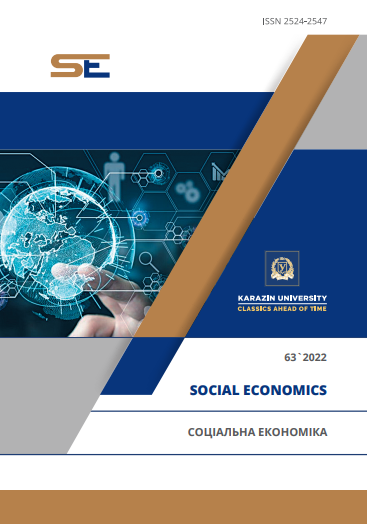AN ASSESSMENT OF LEAN AND AGILE CUSTOMER SATISFACTION IN HUMAN RESOURCES MANAGEMENT
Abstract
Abstract. Financial sector organizations with Human Resources division face with change. Competition, globalization, constantly evolves consumer preferences, these factors are challenges for most of financial organizations in Human Resources Management. Combination with traditional business risks and economy lifecycles are the main reason why financial sector institutions are forced to use Lean and Agile Methods. Customer satisfaction and efficiency play an important role in this tough competition in modern business sector. Lean, Agile or Lean Agile strategy aims to achieve long-term objectives such as Human Resources process efficiency and customer satisfaction. The process of worker selection, continuous skill development, improvement, mistake proofing, reconfiguration for new products are discussed from a human-centric factor perspective. Human factor starts to play the main role. It is important to state that correct form of chosen strategy with customer satisfaction achievement have a significant positive influence on Human Resources division in financial sector profitability. Also, it can be considered as an indicator for future profitability and satisfaction index in financial performance. These outcomes are important for both Human Resources managers and decision makers in financial organization. It can be strongly pointed that Human Resources managers and decision makers can take financial institutions e.g. banks level and trend in customer satisfaction to make assumptions on its future efficiency, productivity and marker performance. Companies that adopt Lean and Agile into Human Resources Management give many thoughts to how employees experience the workplace. In some cases, employees are treated as customers. No innovation provides limitation of growth opportunities in financial institutions sector. It is also stated that there is a relationship between customer satisfaction and efficiency in Human Resources in financial organizational with the help of Lean and Agile Methodology.
Downloads
References
Modig, N., & Åhlström, P. (2014). This is Lean: Resolving the Efficiency Paradox. Rheologica Publishing.
Franklin, M. (2014). Agile Change Management (1st ed.). Kogan Page. Retrieved from https://www.perlego.com/book/1015141/agile-change-management-pdf.
Wysocki, R. K. (2019). Effective Project Management: Traditional, Agile, Extreme and Hybrid. New York: Wiley.
O’Brien, H. (2016). Agile Project Management. A quick start beginner’s guide to mastering Agile Project Management. CreateSpace Independent Publishing Platform.
Rigby, D. Berez, S., & Elk, S. (2020). Doing Agile Right: Transformation Without Chaos. Harvard Business Review Press.
Anderson, D. L. (2019). Organization Design: Creating Strategic and Agile Organizations. SAGE Publications.
Hoyle, L. H., Dorf, D. C., & Jones, T. J. A. (1989). Managing conventions and group business. Educational Institute of the American Hotel & Motel Association.
Anderson, J. (2020). The Return of the Human. Retrieved from https://agilebydesign.com/the-return-of-the-human/.
Peter Cappelli, P., & Tavis, A. (2018). HR goes Agile. Harvard Business Review, March–April 2018, 46–53.
Venugopal, V., & Saleeshya, P. G. (2019). Manufacturing system sustainability through lean and agile initiatives. International Journal of Sustainable Engineering, 12(3), 159-173. doi: https://doi.org/10.1080/19397038.2019.1566411.
Shafiq, M., & Soratana, K. (2019). Lean and Agile Paradigms in Humanitarian Organizations’ Logistics and Supply Chain Management. LogForum, 15 (1), 139-153. doi: http://doi.org/10.17270/J.LOG.2019.294.
Deksnys, M. (2018). Organizational Agility in High Growth Companies. (Doctoral Dissertation). Retrieved from https://repository.mruni.eu/handle/007/15317.
Crocitto, M., & Youssef, M. (2003). The Human Side of Organizational Agility. Industrial Management and Data Systems, 103 (6), 350-385.
Dove, R. (1996). Tools for Analyzing and Constructing Agility. Agility Forum, 1-12.
Dove, R. (2005). Agile Enterprise Cornerstones: Knowledge, Values and Response Ability. Business Agility and Information Technology Diffusion, 180, 311-320.
IBM Knowledge Center. (2014-2015). IBM Knowledge Center.
Strzyzewska, M. (Ed.). (2009). Selected Methodological Issues for Doctoral Students. Warsaw School of Economics.
Liker, J. K. (2004). Toyota Way: 14 Management Principles from the World’s Greatest Manufacturer. 1st ed. New York: McGraw-Hill Education. Retrieved from https://www.accessengineeringlibrary.com/content/book/9780071392310.
Womack, J. P., & Jones, D. T. (2000). Lean Thinking. Free Press.
Nedzinskas, Š. (2013). Dynamic capabilities and organizational inertia interaction in volatile environment. (Doctoral Dissertation). University of Management and Economics, Vilnius, Lithuania. Retrieved from http://archive.ism.lt/bitstream/handle/1/301/ETD2013-44_%C5%A0ar%C5%ABnas%20Nedzinskas.pdf?sequence=1.
Thoren, P. M. (2017). Agile People: A Radical Approach for HR & Managers (That Leads to Motivated Employees). Lioncrest Publishing.
Kelly Swingler, K. (2017). Agile Human Resources. Business Expert Press.
Jeff Gothelf, G., & Seiden, J. (2017). Sense and Respond. Harvard Business Review Press.
Gibson, A. (2021). Agile Workforce Planning. Kogan Page.
Bankston, A. (2018). HR in Agile Organization. Lulu.com
Trost, A. (2019). Human Resources Strategies: Balancing Stability. Springer.
Jaramillo, S., & Richardson, T. (2016). Agile Engagement. Wiley.
Younger, J., & Smallwood, N. (2016). Agile Talent: How to Source and Manage Outside Experts. Harvard Business Review Press.
Schmidt, L. (2021). Redefining HR: Transforming People Teams to Drive Business Performance. Kogan Page.
Denning, S. (2018). The Age of Agile. AMACOM.
Winter, R. (2015). Agile Performance Improvement. Apress Berkeley. doi: https://doi.org/10.1007/978-1-4842-0892-2.
Moreira, M. E. (2017). The Agile Enterprise: Building and Running Agile Organizations. Apress Berkeley. doi: https://doi.org/10.1007/978-1-4842-2391-8.




